Jim and I were so desperate for some blue sky and dry air that we left our
beloved Denali National Park a day early.
When we woke up to more rain on Monday morning and realized it would be raining
for the next week in the park we decided to head for Anchorage,
where we found more sun.
Our odds of drier weather this week were considerably better in
Anchorage than Denali. The temps have been 5-10 degrees warmer in
Anchorage, too. We awoke to upper 40s F. at Riley Creek that morning and
enjoyed upper 60s, moderate humidity, and partly sunny skies a few hours
later at Joint Base Elmendorf-Richardson (JBER).
It rained most of the way to Willow, then brightened up a bit by the time
we got to the north end of Cook Inlet:
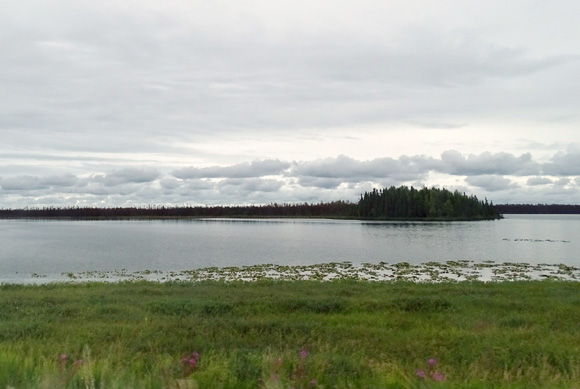
In this entry I'll
show some scenes from our five-hour drive along the Parks and
Glenn Highways, our new campsite, and some activities on base.
THE DRIVE FROM DENALI TO JBER
On a clear day, this is a memorable drive with stunning views of
Denali and other mountains in the Alaska and Chugach Ranges.
On Monday, unfortunately, it was mostly a wet and/or overcast mess
with limited views until we got near metro Anchorage.

We didn't even decide to leave Denali NP until shortly after we got up
that morning. In just an hour we ate breakfast, made our decision (it
was an easy one -- no refund, but no regrets), got
the Cameo ready for travel, vacated our campsite, and went to the nearby
dump station to get rid of most of our clean, gray, and black water
weight.
We drove south from the park entrance on the Parks Hwy. and Glenn
Hwy. to exit 8, the most northerly gate we can use at JBER.
Traffic was moderate the whole way. There were several areas of active road
work where traffic got slowed down or stopped, so lots of vehicles ended
up behind us and other RVs heading south and had to pass us when they
could.
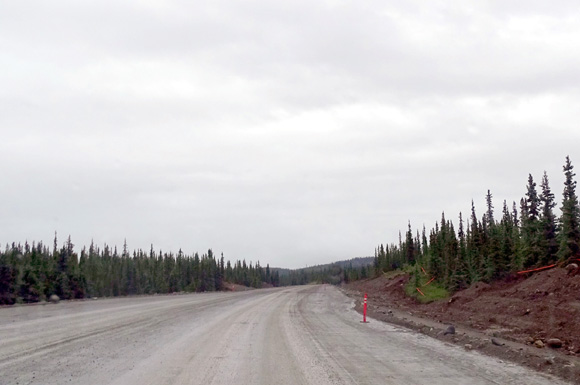
I'm surprised so much road work is done on rainy days. Good thing, or
they'd never get it done during Alaska's very abbreviated
spring-summer-fall season.
In addition to one traffic stop of five minutes we took a break at the
Denali South Viewpoint to eat lunch. There were no views with low clouds
and rain, so no use taking pictures in that location.

Lake at
Broad Pass, with mountains partly obscured
We also got diesel fuel at the Tesoro near the Talkeetna intersection,
about MP 100 on the Parks Hwy. The cost was $3.31/gallon, much better
than in Healy or Cantwell but more expensive than Anchorage.
The fireweeds along the Parks Hwy. were more dense and prettier the
farther south we got:

I didn't know if
they'd still be blooming near Anchorage since they were at their peak
farther north in Denali NP.
CAMPING AT BLACK SPRUCE RV PARK
Coming into the base felt like coming home! This is our fifth stay here
(second time this summer + three times in 2012).

When we pulled up to the campground host's cabin near the entrance we could see at
least two empty spots at the beginning of the first loop.
Dan greeted us and said to
pick any spot we wanted -- all the sites now have full electric
power! Only half the sites had electricity when we were here several weeks ago. Good thing they got
the system fixed because the campground
has been mostly full this week.
We took the first site on the right because it has a stronger phone/MiFi
signal than the two sites we occupied earlier in the month:

Above and
below: room to park the truck in front or back;
plenty of
shade and space on the doorside for relaxation, too
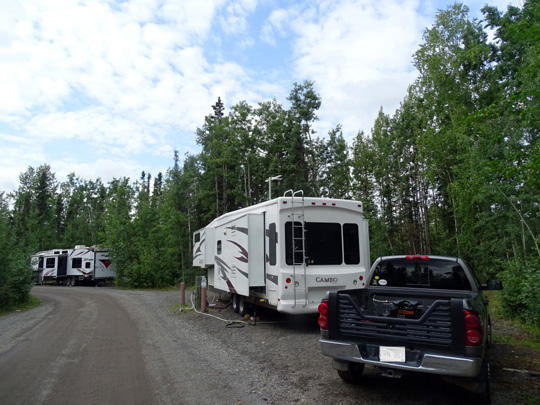
The electricity, water, and sewer work just fine in this site. It took a
couple days to get the camper dried out inside because of all the
moisture from rain and propane heat at Denali. With electricity we can
run the dehumidifier and electric space heaters, which don't put out any
moisture. We're happy to have
full hookups, "free" WiFi, and a TV signal again.
After we got settled in Jim
went to the MWR office to pay for our site for the next six days. At
$33/day it's not exactly cheap but it's less expensive than any private
campground in this area and Black Spruce is far nicer.
When I was walking Casey around the campground the first day I saw a
familiar face -- Ron, a full-time RVer who used to live in Virginia.
We first met him and his husky, Aspen, at Kings Bay Sub Base in southern
Georgia last winter. Unfortunately, Ron had to put Aspen down the day
before our arrival due to a
serious lung problem. As soon as he gets his buddy's ashes he'll be
heading back to the area where he used to live so he can adopt a husky
rescue. (I tried unsuccessfully to encourage him to remain in Alaska the
rest of the summer and get another dog in "Husky Central" but he had
other ideas.)

Our sweet pups: Casey at
almost 3 years old, Cody at 12+, and one of their stuffed toys
(8-1-15)
Ron's understandably very upset about losing Aspen. We'd be very upset
if we had to put one of our dogs to sleep, too. I'm glad we were
able to spend time with Ron this week so he could talk to other dog
lovers about his loss and he could get some puppy love from Casey and
Cody. He decided to move his 5th-wheel to the site across from us so
he'd have a better internet signal and we could all spend more time
together.
ACTIVITIES ON BASE & IN THE ANCHORAGE AREA
I miss Denali National Park but with all the rain predicted there in the
next week or two, I'm glad to be back in Anchorage where we at least
have electricity to stay warm and dry for the next six days. Jim's
happier when we have TV, too.
It also gives us more time to attend to some basics before we head to the Kenai
Peninsula -- stocking up on groceries and supplies again at
WalMart, Sam's Club, PetsMart, and other big box stores,
changing the oil in the truck at the auto hobby shop on base, shampooing the carpet, etc.
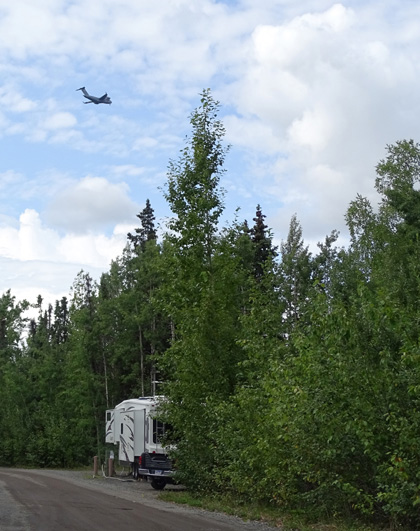
A C-17 cargo
plane flies over our campground.
Air Force bases are noisy, but it's fun to
watch the aircraft.
I've been walking the dogs in the campground and other areas on base
this week, as well as off-base. I'll have separate entries about several
hikes in the Chugach Mountains and at Eagle River.
Jim has been riding his bike and playing ball with Casey at least twice
a day. She's able to go five to ten miles at a time, slowly. Jim likes to take her to Fish Creek to
swim and watch for moose, bears, and salmon:

Above and below: Fish Creek runs through this
little park on base,
a couple miles from our campground.

Jim and I both enjoy riding on this large base and the extensive network
of bike paths in the metro Anchorage area. I'll have a separate entry with photos
from the Campbell Creek ride we did this week.
Since Jim doesn't have any more bike races scheduled he isn't as focused
on long rides now. He was disappointed in the road at Denali NP;
he remembers having a lot more fun riding there three years ago than he
did this time. A big reason is that neither of us saw nearly as many
bears, moose, caribou, wolves, Dall sheep, or other critters at Denali
this summer when we were cycling and hiking.
ANOTHER EARTHQUAKE!
On Tuesday
we got shaken by another earthquake after supper.
Jim was out in the truck and I was in the camper with the dogs. He
thought I was jumping up and down on the bumper of the truck and I
thought he was up on the roof or rocking the camper somehow! He realized
before I did that it was an earthquake. We aren't used to these
things.
Here's an
article on the Alaska Dispatch News
website about the earthquake:
After shocks ripple through
Alaska after unusual 6.3-magnitude quake
by Laurel Andrews
As of Wednesday
morning, about a dozen aftershocks had been recorded from the
earthquake, which originated at a depth of 73 miles, said
seismologist Natalia Ruppert.
The aftershocks from
Cook Inlet's Tuesday quake have been relatively small -- the
largest was magnitude 3, Ruppert said. But the quake was
unusual given its magnitude and depth, she said.
"We looked up some of
the history in this region, and the last time we had a similar
earthquake in Cook Inlet, it was … in 1988," Ruppert said.
Tuesday's quake was "the largest since that 1988 (quake) in
the deeper portion of the seismic region," Ruppert said.
While the earthquake
originated roughly 9 miles southwest of the Mount Iliamna
volcano and 43 miles southwest of Mount Redoubt, the tremor
was not related to volcanic activity, according to the Alaska
Volcano Observatory.
"It's pretty clear
that this was a tectonic earthquake not related to the
volcanoes," said David Fee, acting coordinating scientist with
the agency.
Among distinguishing
factors, the depth of the earthquake and relatively large
magnitude helped determine that it was tectonic. Most volcanic
earthquakes in Alaska register at magnitude 1 or 2, Fee said.
"Volcanically, this is
below us," Fee said, so the agency wasn't too involved in
monitoring the seismic event.
AND MORE RAIN . . .
We weren't able to completely avoid rain by
moving a day early to Anchorage but it was still a good decision. We've had intermittent rain and sun since our
arrival in Anchorage -- not as much sun as we'd hoped, but not so
bad since we have electricity, TV, and more things to do indoors in
Anchorage than at Denali.
Neither of us is motivated to get out and do much when it's rainy/misty.
Three years ago everything here was new to us and we didn't know if we'd
ever be back. We just got out and did things more then, even in the
rain.

Two fighter
jets come in for a landing at JBER. The runways are a couple miles from
the campground.
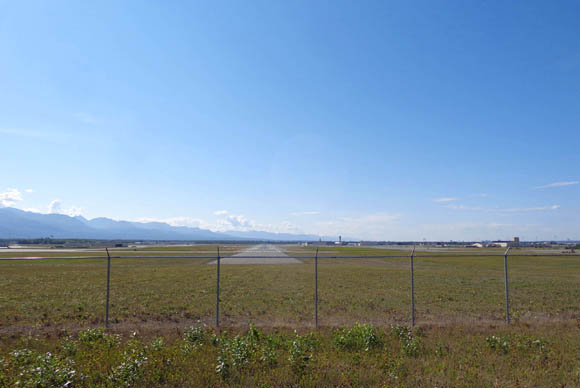
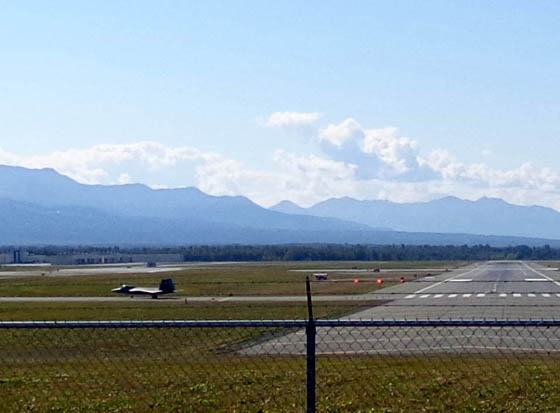
Our lifestyle and
attitudes have morphed since we became full-timers -- we are more
relaxed and less frenetic now. If we miss a thing or two, oh well.
In addition, this is
our second time to spend all summer in Alaska.
Some of the things we did as first-time visitors we aren't compelled to
do again.
We're adding some new venues and activities this time but this whole
trip is more relaxed since it's the second time around.
Once again, we don't know if we'll ever be back up here again. I made a
list today of things to do even in the rain, just in case this IS the
last time I'm ever in Alaska.
I'll start on that list tomorrow, when it's supposed to be nicer weather
. . . <wink>
Next entry: our hike at the Eagle River Nature
Center and bike ride along Campbell Creek
Happy trails,
Sue
"Runtrails & Company" - Sue Norwood, Jim O'Neil,
Cody the ultra Lab, and Casey-pup
Previous
Next
© 2015 Sue Norwood and Jim O'Neil















